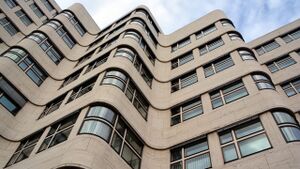Dealbhtaigh architecture
Dealbhtaigh, or 'living design', refers to both the Dealbhtaigh architectural firm and the architectural style of the same name. In recent years, it has expanded to include modernist art in the same style as the graphics and interior design aesthetic produced by these, referred to as Dealbhtaigh Style. Founded in Leighlinbridge in 1948 by two partners, Kerry MacLinney and Richard Reaen, the firm became a sensation and a predominant influence in Fhainnin building design in the latter half of the 20th Centyury, inspiring numerous copycat architects and informing much of the basis of the currently dominant New Millennium style.
Top: | |
| Years active | 1948-1990s |
|---|---|
| Country | Primarily Faneria, International |
| Influences |
|
| Influenced | Fhainnin New Millennium style |
| Dealbtaigh Architectural Group | |
|---|---|
 DBAG Logo, 1948 | |
| Practice information | |
| Firm type | Architectural Design |
| Partners | Kerry MacLinney, Richard Reaen |
| Founded | 1948 |
| Dissolved | 1977 |
| No. of employees | 85 (over lifetime) |
| Location | Based in Leighlinbridge, Faneria |
| Affiliations | New Culture Movement |
| Significant works and honors | |
| Buildings |
|
| Awards |
|
Firm
Founding
The founders of the partnership, Kerry MacLinney and Richard Reaen, were both veterans of the Second Great War; Reaen had served as an officer in the mechanized Republican Guards and had previously studied structural engineering, while MacLinney had been a conscripted machine designer working on factory lines for essential parts manufacturing. Post-war, Reaen returned for his Masters' Degree, while MacLinney practiced at another firm, Reade and Culloch. The two met in 1945 when Reaen joined the firm as an apprentice, and the two began their own firm in 1948 after Reade and Culloch broke up temporarily due to financial instability.
Practice
Closing
The firm formally closed in 1977 after with one of its partners, MacLinney, became ill and retired at the age of 68. The firm's office was retained by Reane, who used it as his own practice and kept the same staff on until his own retirement in late 1983.
Style
The color patterns and structural forms used in Dealbhtaigh style buildings is almost always based in the Geometric Absolutism movement of the 1880s, with squares, triangles, and rectangles being the most common shapes that can be picked out of a structure and circles and rounded edges being uncommon at first but more prevalent in later works. Ovals are extremely rare but do occasionally appear for windows and color patterns. This is a slight departure from traditional moors of Urceo-Burgundine Transcendentalism, which explicitly bans the use of ovals and heavily discourages the use of circles on the vertical plane, while Reaen and MacLinney used them both on the horizontal and vertical.
Dealbhtaigh is unique in Fhainnin architectural history, even after its heyday, in its eschewing of integrating plant life into any portion of its structures, preferring a clinical, starkly 'human-centered' atmosphere in contrast to the 'nature centered' traditional method of Fhainnin practice.
Ornamentation
Reaen was no stranger to incorporating unusual ideas into his work, and many of his middle and later projects featured the use of banner windows and a type of side-opening multi-paned window that could be set to either side to deflect or channel airflow into a space. He also pushed heavily for the adoption of interior design as a consideration in the overall design of a building, a concept generally disparaged by contemporary Fhainnin architects that won him a great deal of favor with clients. His work was often comparatively dull on the outside, using primarily traditional dull reds, wooden browns, tans, and cream colors, while the interiors of his structures were designed with similarly colored main spaces and a great variety of colorful and bright alcoves, nooks, and smaller rooms off of the primary walkways that usually had a cohesive interior color coded set of functions and drew visitors into smaller, more heavily decorated spaces. These color codes often were unique to each project and did not correspond to other buildings of his; red bands along the walls could direct a person to a library cafe in one structure and run around the corners and edges of communal rooms of apartment complexes with no relation between the two structures' color codes.
Materials
In material use, Reaen accepted the use of backing up stonework facades with metal and concrete supports and foundations, but this hardly made him stand out in among his peers. MacLinney was the primary innovator in materials use, practicing with plaster and concrete to create textured surfaces that helped alleviate the issues present in Kilikas Brutalism's intense use of sheer concrete faces. MacLinney experimented with coloring concrete and plaster during mixing and curing to allow for a wider variety of options in rustication, external ornamentation, and construction methodology. MacLinney was greatly invested in civic and city design and often oversaw the creation of better massed housing and taller structures. He believed that working towards and ultimately building a native style of skyscraper beyond the traditional red-brick high rise of the 1800s would ensure Faneria remained relevant and abreast in the modern architectural scene. This would culminate in theoretical designs for a 32-story skyscraper MacLinney dubbed 'the new northern leviathan of brick and steel and concrete' with a series of five towers spanned by indoor walkways that could act as a city block, complete with indoor shopping, housing, parking, and numerous other amenities designed to circumvent the social issues often created by mass housing. Unfortunately, the cost of such a project was utterly beyond even the prestigious firm's means to bankroll or borrow for, and Reaen preferred to complete work rather than propose theoreticals, where MacLinney excelled.
Non-structure Projects
Reaen and MacLinney, along with other partners, also did design work creating early retro casings for some of Faneria's first 'small' computers, beginning with a 20'x12'x12' case for a prototype in 1976, near the end of the firm's lifetime. The firm disbanded in 1977, when MacLinney went into retirement, consulting for other firms and state bodies afterwards. Reaen continued to practice as an architect for another six years before retiring himself and doing graphic design work for government paperwork, materials, and newer computer casings. One of his last pieces, a 12"x12"x6" proposed 'home computer of the future' casing could not fit a personal computer when it was designed but has since become the direct inspiration for an almost identical small desktop casing still manufactured today, with the exception of ports and mounting systems being updated to account for technological leaps since then.
Modern Influence
The main influence of Dealbhtaigh was to reinvigorate the architectural scene in Faneria and introduce a greater willingness to experiment to its community, bridging traditional red brick bastion-style architectural design with modern materials and form theory in a way mostly palatable to Fhainnin culture's conservative elements. It became a direct predecessor of the currently vogue New Millennium style, which uses a greater focus on positive spacing in its color theory, reinforces the use of brick facades, incorporates new window patterns and deliberately asymmetrical facings, and integrates a heavy reliance on earthworks, terracing, and integrated garden spaces.


